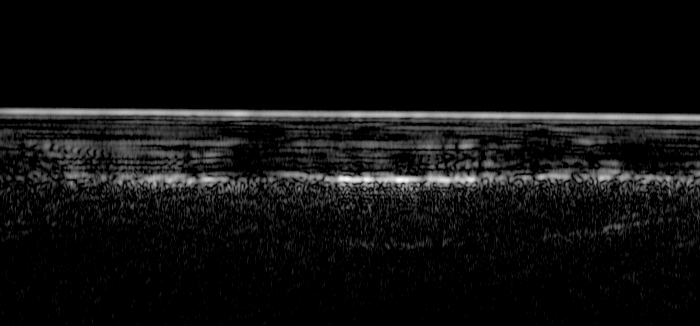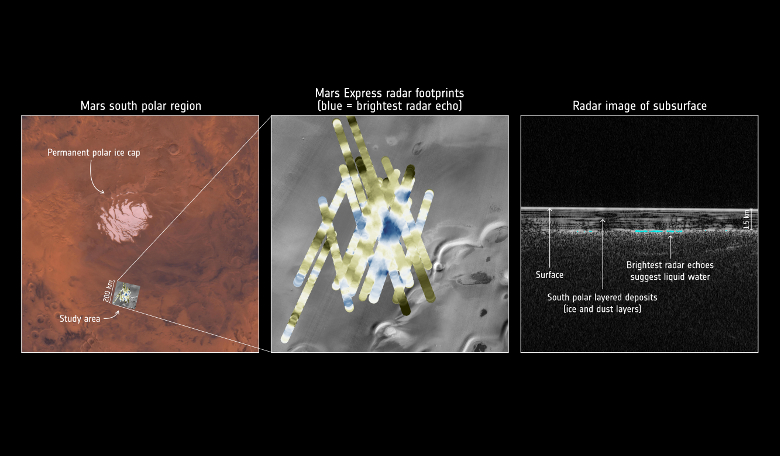Debate has raged for decades over just how wet Mars might have been in its early history and now a discovery by ESA’s Mars Express could help clarify the conundrum as the spacecraft has found what appears to be a pool of liquid water buried under the surface of the martian south polar region.
Mars is littered with many geological features whose origin could be interpreted in numerous ways. Were the huge canyons and valleys, such as Valles Marineris that cut across large swathes of the surface, carved from water, tectonic or volcanic activity for example?
If these and many other alluring attributes were created by vast channels of flowing water or static lakes slowly eroding away the bedrock, any lingering liquid stuff is long gone - on the surface at least. Water ice and possible carbon dioxide ice does exist at the martian poles however and the presence of liquid water at the base of the polar ice caps has long been suspected.
Indeed if the water ice contained at the South Pole melted today, then scientists say that the entire surface of the planet would be covered by an ocean 11 metres deep. But finding an unfrozen patch in its liquid state has so far evaded detection by any overhead orbiter or planet-bound rover.
Now though, by bouncing radar signals through underground layers of ice, researchers using the Mars Advanced Radar for Subsurface and Ionosphere Sounding instrument, MARSIS, onboard Mars Express have detected the previously undetectable; a particularly bright radar reflection 1.5 kilometres underground, that stretches for about 20 kilometres.
The bright feature has been interpreted as an interface between the upper layers of ice and a stable body of liquid water, possibly one which is rich in salty, saturated sediments and for MARSIS to be able to detect such a body of water, it would need to be at least several tens of centimetres thick.
“This subsurface anomaly on Mars has radar properties matching water or water-rich sediments,” says Roberto Orosei, principal investigator of the MARSIS experiment and lead author of the paper published in the journal Science.
“This is just one small study area; it is an exciting prospect to think there could be more of these underground pockets of water elsewhere, yet to be discovered.”
The team had seen hints of interesting subsurface features before but because the sampling rates and resolution of the data was previously too low, those involved were unable to reproduce the result from orbit to orbit said Andrea Cicchetti, MARSIS operations manager and a co-author on the new paper.
But by labouring over ways in which to improve upon information collected by the spacecraft, the team came up with a new operating mode to bypass some onboard processing. “Now we see things that simply were not possible before,” added Cicchetti.
Microbial life survives some of the harshest conditions on Earth, including within subglacial environments. Could comparable underground pockets of salty, sediment-rich liquid water on Mars also provide a suitable breeding ground for this type of life-form, either now or in the past?
“This thrilling discovery is a highlight for planetary science and will contribute to our understanding of the evolution of Mars, the history of water on our neighbour planet and its habitability,” added Dmitri Titov, ESA’s Mars Express project scientist.

This image shows an example radar profile for one of 29 orbits over the 200 x 200 km study region in the south polar region of Mars. The bright horizontal feature at the top corresponds to the icy surface of Mars. Layers of the south polar layered deposits – layers of ice and dust – are seen to a depth of about 1.5 km. Below is a base layer that in some areas is even much brighter than the surface reflections, while in other places is rather diffuse. The brightest reflections from the base layer – close to the centre of this image – are centred around 193°E/81°S in all intersecting orbits, outlining a well-defined, 20 km wide subsurface anomaly that is interpreted as a pond of liquid water. Image: ESA/NASA/JPL/ASI/Univ. Rome; R. Orosei et al 2018











